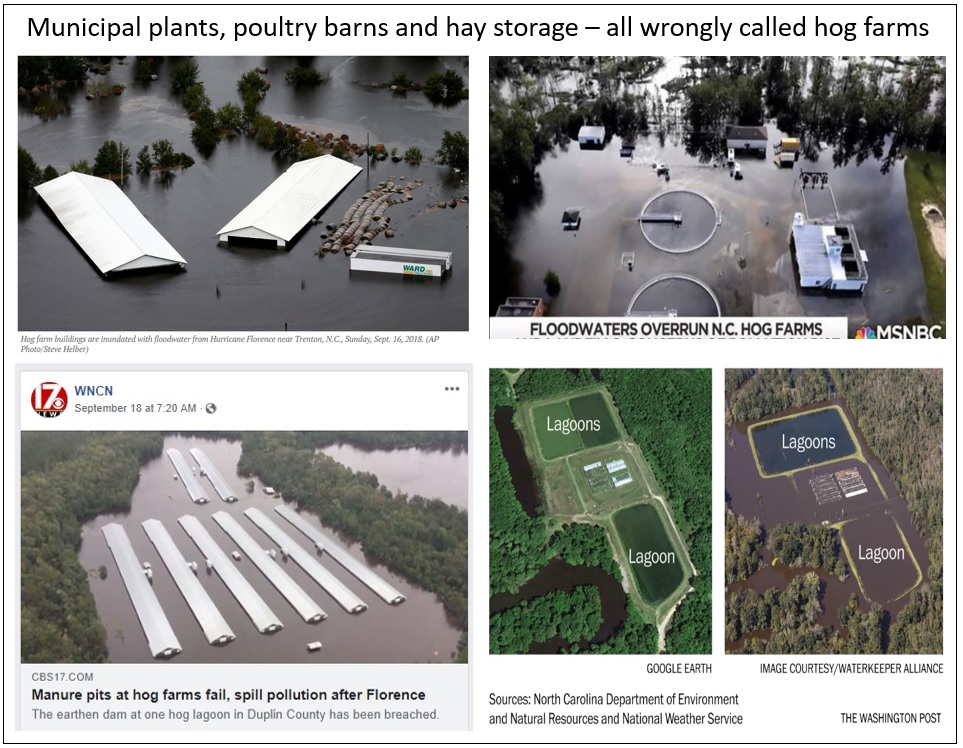An Associated Press article published in advance of the arrival of Hurricane Dorian begins like this: “The names of hurricanes may change, but one thing seems to stay the same: Misinformation spreads quickly…”
We cannot agree more. The pork industry in North Carolina has been a victim of misinformation before, during and after recent hurricanes.
Some of it is the result of a deliberate campaign by certain activist groups who are running coordinated campaigns meant to attack hog farmers – campaigns that themselves are dishonest. Other times, it is the result of media outlets that are quick to believe the worst about our farms and can’t (or don’t) verify what they are told.

Farm buildings, at left, and municipal waste plants, on the right, have been misidentified as flooded hog operations.
Time and time again
Before storms like Dorian, activists who oppose livestock agriculture often warn of environmental threats from hog farms — even though post-storm assessments later prove those fears completely unfounded.
Then, once the storm passes, the activists hop into small planes in search of anything that looks like a hog farm under water. They snap photos and share images with media outlets that are anxious to chronicle the storm’s damage, but not so anxious to check facts.
The result: the media, time and time again, has published photos in the immediate aftermath of a hurricane that wrongly identified flooded properties as hog farms.
The AP ran a photo of a flooded hay farm and called it a hog farm. The Washington Post published a photo of a flooded municipal wastewater treatment plant and called it a hog farm. Major national networks published photos of poultry farms that were misidentified as hog farms.
The media also publishes misleading information about how many animals died as a result of the storm. In a state that has about nine million pigs in standing stock, Hurricane Florence’s historic rains resulted in the loss of about 5,500 pigs. Nonetheless, some headlines screamed that “millions” died as a result of the storms.
By the time we correct these errors, the damage is done.
We urge caution
For an industry that has made tremendous strides in how it prepares for hurricanes, it is disheartening.
So, the next time you see something negative about our farms during a hurricane, don’t be so quick to assume it’s true.
And remember these facts: Our farms in the past three years saw minimal impacts from two of the worst hurricanes to ever hit our state. Despite receiving more than three feet of rain during Hurricane Florence, 98% of our anerobic treatment lagoons were not negatively impacted by the storm.
This is a result of tremendous strides in management and preparation. Additionally, since Hurricane Floyd in 1999, more than 325 treatment lagoons located in flood-prone areas have been permanently closed through a voluntary buyout program. That program continues today.
Facts show that the real environmental threat from hurricanes comes in the form of municipal waste systems. During Hurricane Florence, more than 200 municipal wastewater treatment systems were compromised, spilling at least 121 million gallons of sewage into the state’s waterways.
That is why, in the aftermath of Florence, NC DEQ Secretary Michael Regan said: “We are really focused on our wastewater treatment facilities because there are probably orders of magnitude more human waste that has escaped these wastewater treatment facilities than what has escaped these hog lagoons.”
We request caution and restraint, especially during hurricanes. And we ask that you don’t believe tall tales — like one published by the Washington Post with the alarmist and false headline, “I saw Florence sending millions of gallons of animal poop flooding across North Carolina.”
The great writer Jonathan Swift knew well about this sort of thing.
He once said: “Falsehood flies, and truth comes limping after it.”
